MNG82001 - Reflective Case Study: Teamwork and Leadership Challenges
VerifiedAdded on 2023/03/23
|7
|1463
|36
Case Study
AI Summary
This reflective case study, based on a retail company in Australia, examines the effectiveness of teamwork within an organization. Mary, a newly appointed team leader, faces challenges as team members prioritize individual goals over collaboration, leading to conflicts and a lack of support. The case study presents two key questions: what Mary should have done to build relationships among team members and the challenges they face. The analysis suggests that Mary could have implemented team-building sessions to foster communication, establish decision-making processes, and address conflicts. The challenges identified include poor change management, lack of transparency, low involvement, tension, conflict, and lack of trust. The study emphasizes the importance of effective leadership and team dynamics in achieving organizational goals and highlights strategies for improving teamwork and resolving conflicts within a retail setting. The assignment concludes with relevant references to support the findings and recommendations.
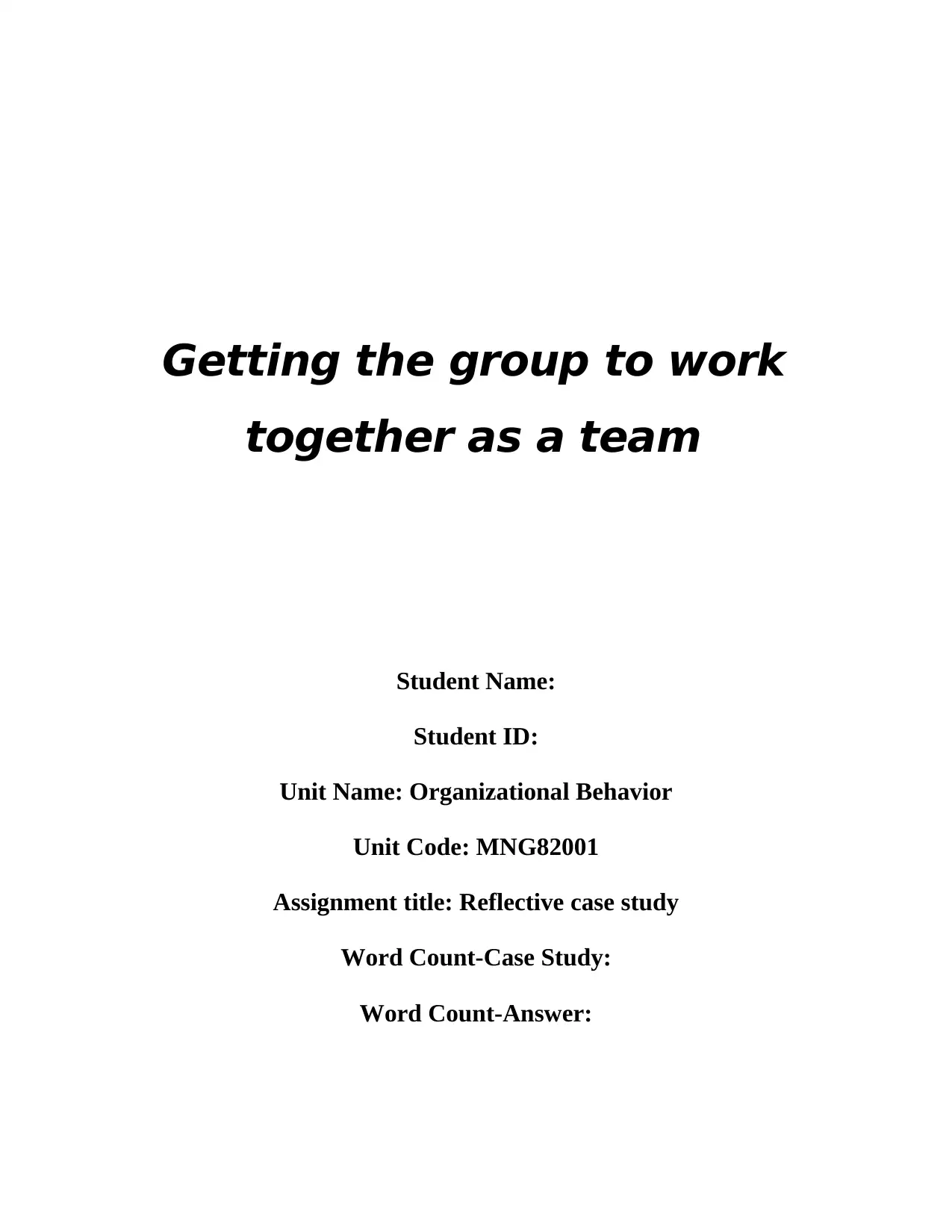
Getting the group to work
together as a team
Student Name:
Student ID:
Unit Name: Organizational Behavior
Unit Code: MNG82001
Assignment title: Reflective case study
Word Count-Case Study:
Word Count-Answer:
together as a team
Student Name:
Student ID:
Unit Name: Organizational Behavior
Unit Code: MNG82001
Assignment title: Reflective case study
Word Count-Case Study:
Word Count-Answer:
Paraphrase This Document
Need a fresh take? Get an instant paraphrase of this document with our AI Paraphraser
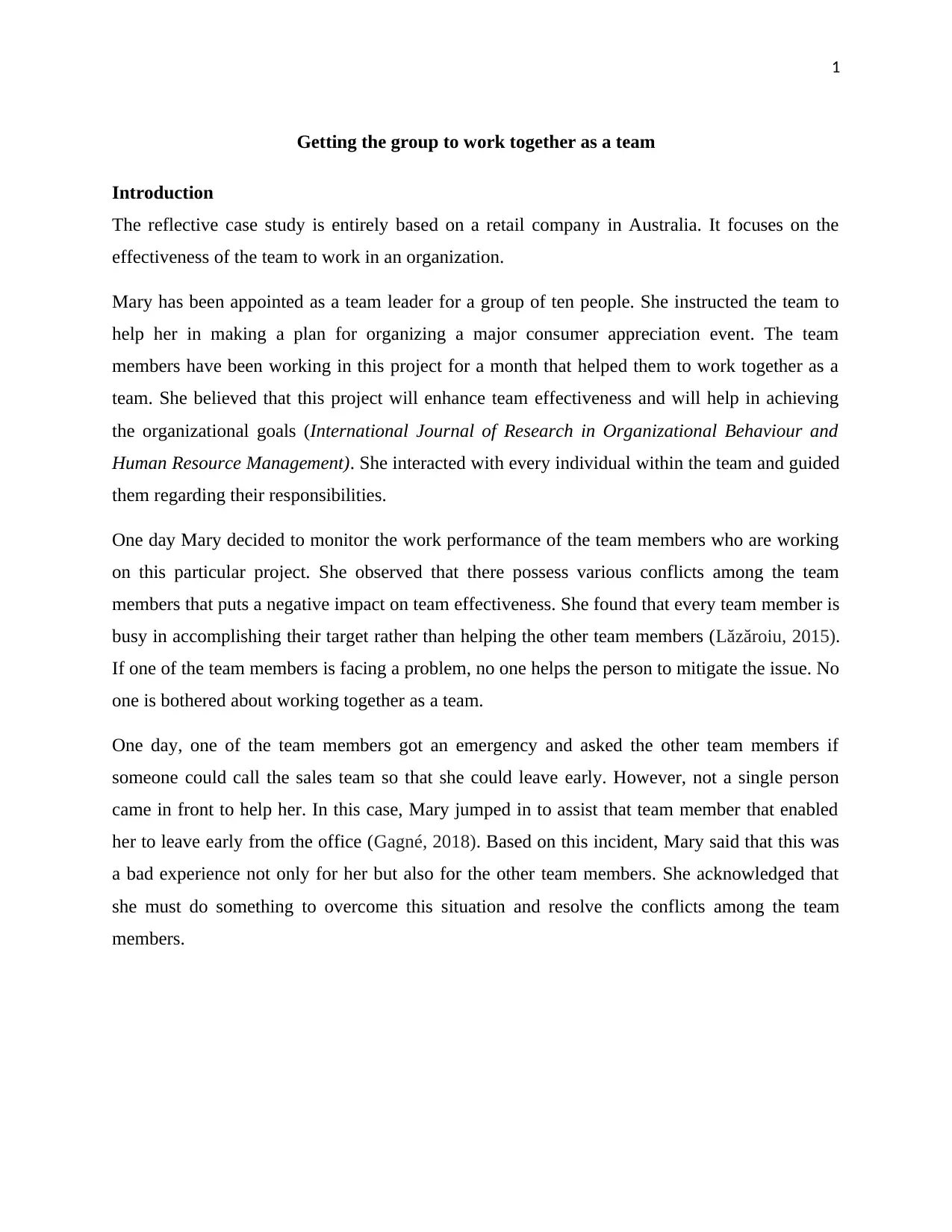
1
Getting the group to work together as a team
Introduction
The reflective case study is entirely based on a retail company in Australia. It focuses on the
effectiveness of the team to work in an organization.
Mary has been appointed as a team leader for a group of ten people. She instructed the team to
help her in making a plan for organizing a major consumer appreciation event. The team
members have been working in this project for a month that helped them to work together as a
team. She believed that this project will enhance team effectiveness and will help in achieving
the organizational goals (International Journal of Research in Organizational Behaviour and
Human Resource Management). She interacted with every individual within the team and guided
them regarding their responsibilities.
One day Mary decided to monitor the work performance of the team members who are working
on this particular project. She observed that there possess various conflicts among the team
members that puts a negative impact on team effectiveness. She found that every team member is
busy in accomplishing their target rather than helping the other team members (Lăzăroiu, 2015).
If one of the team members is facing a problem, no one helps the person to mitigate the issue. No
one is bothered about working together as a team.
One day, one of the team members got an emergency and asked the other team members if
someone could call the sales team so that she could leave early. However, not a single person
came in front to help her. In this case, Mary jumped in to assist that team member that enabled
her to leave early from the office (Gagné, 2018). Based on this incident, Mary said that this was
a bad experience not only for her but also for the other team members. She acknowledged that
she must do something to overcome this situation and resolve the conflicts among the team
members.
Getting the group to work together as a team
Introduction
The reflective case study is entirely based on a retail company in Australia. It focuses on the
effectiveness of the team to work in an organization.
Mary has been appointed as a team leader for a group of ten people. She instructed the team to
help her in making a plan for organizing a major consumer appreciation event. The team
members have been working in this project for a month that helped them to work together as a
team. She believed that this project will enhance team effectiveness and will help in achieving
the organizational goals (International Journal of Research in Organizational Behaviour and
Human Resource Management). She interacted with every individual within the team and guided
them regarding their responsibilities.
One day Mary decided to monitor the work performance of the team members who are working
on this particular project. She observed that there possess various conflicts among the team
members that puts a negative impact on team effectiveness. She found that every team member is
busy in accomplishing their target rather than helping the other team members (Lăzăroiu, 2015).
If one of the team members is facing a problem, no one helps the person to mitigate the issue. No
one is bothered about working together as a team.
One day, one of the team members got an emergency and asked the other team members if
someone could call the sales team so that she could leave early. However, not a single person
came in front to help her. In this case, Mary jumped in to assist that team member that enabled
her to leave early from the office (Gagné, 2018). Based on this incident, Mary said that this was
a bad experience not only for her but also for the other team members. She acknowledged that
she must do something to overcome this situation and resolve the conflicts among the team
members.
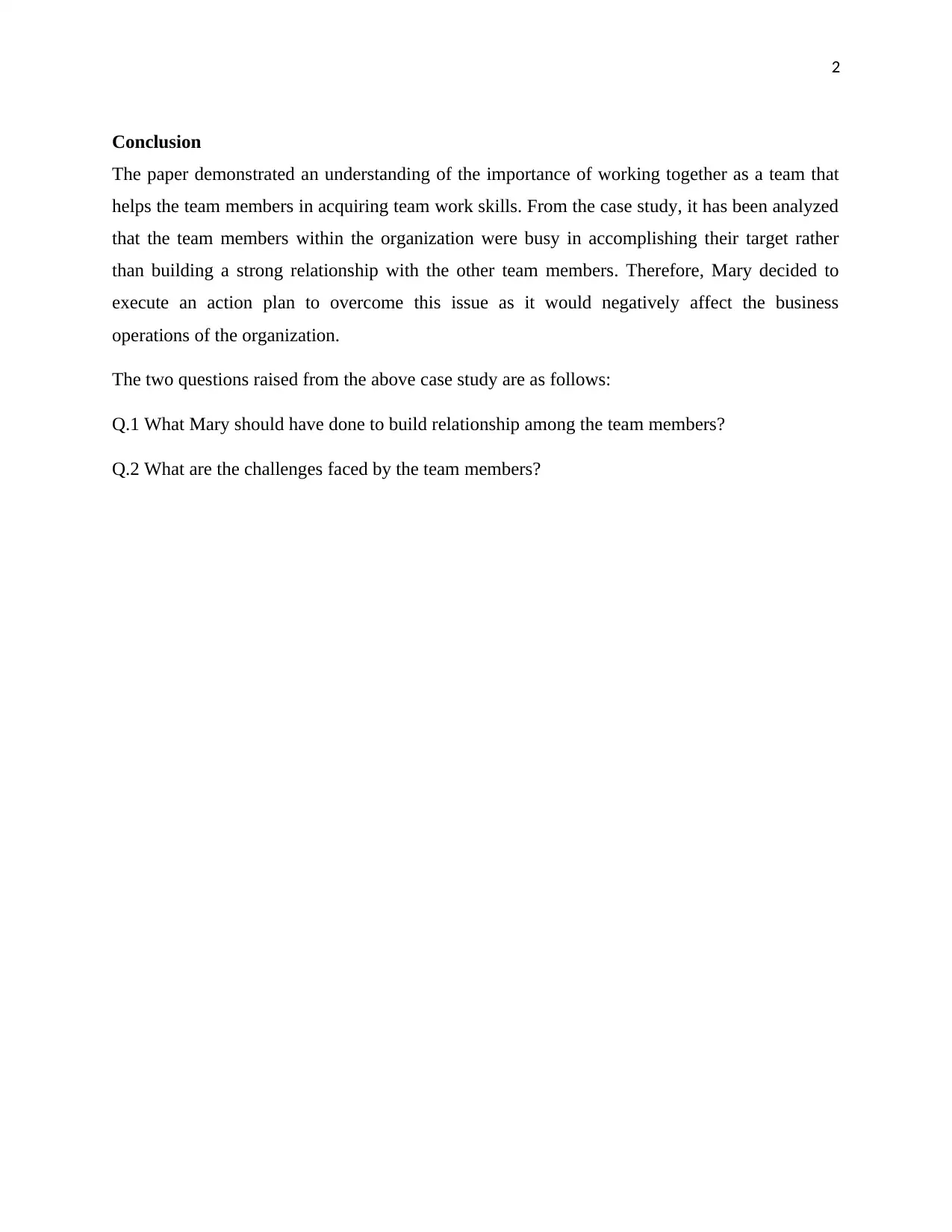
2
Conclusion
The paper demonstrated an understanding of the importance of working together as a team that
helps the team members in acquiring team work skills. From the case study, it has been analyzed
that the team members within the organization were busy in accomplishing their target rather
than building a strong relationship with the other team members. Therefore, Mary decided to
execute an action plan to overcome this issue as it would negatively affect the business
operations of the organization.
The two questions raised from the above case study are as follows:
Q.1 What Mary should have done to build relationship among the team members?
Q.2 What are the challenges faced by the team members?
Conclusion
The paper demonstrated an understanding of the importance of working together as a team that
helps the team members in acquiring team work skills. From the case study, it has been analyzed
that the team members within the organization were busy in accomplishing their target rather
than building a strong relationship with the other team members. Therefore, Mary decided to
execute an action plan to overcome this issue as it would negatively affect the business
operations of the organization.
The two questions raised from the above case study are as follows:
Q.1 What Mary should have done to build relationship among the team members?
Q.2 What are the challenges faced by the team members?
⊘ This is a preview!⊘
Do you want full access?
Subscribe today to unlock all pages.

Trusted by 1+ million students worldwide
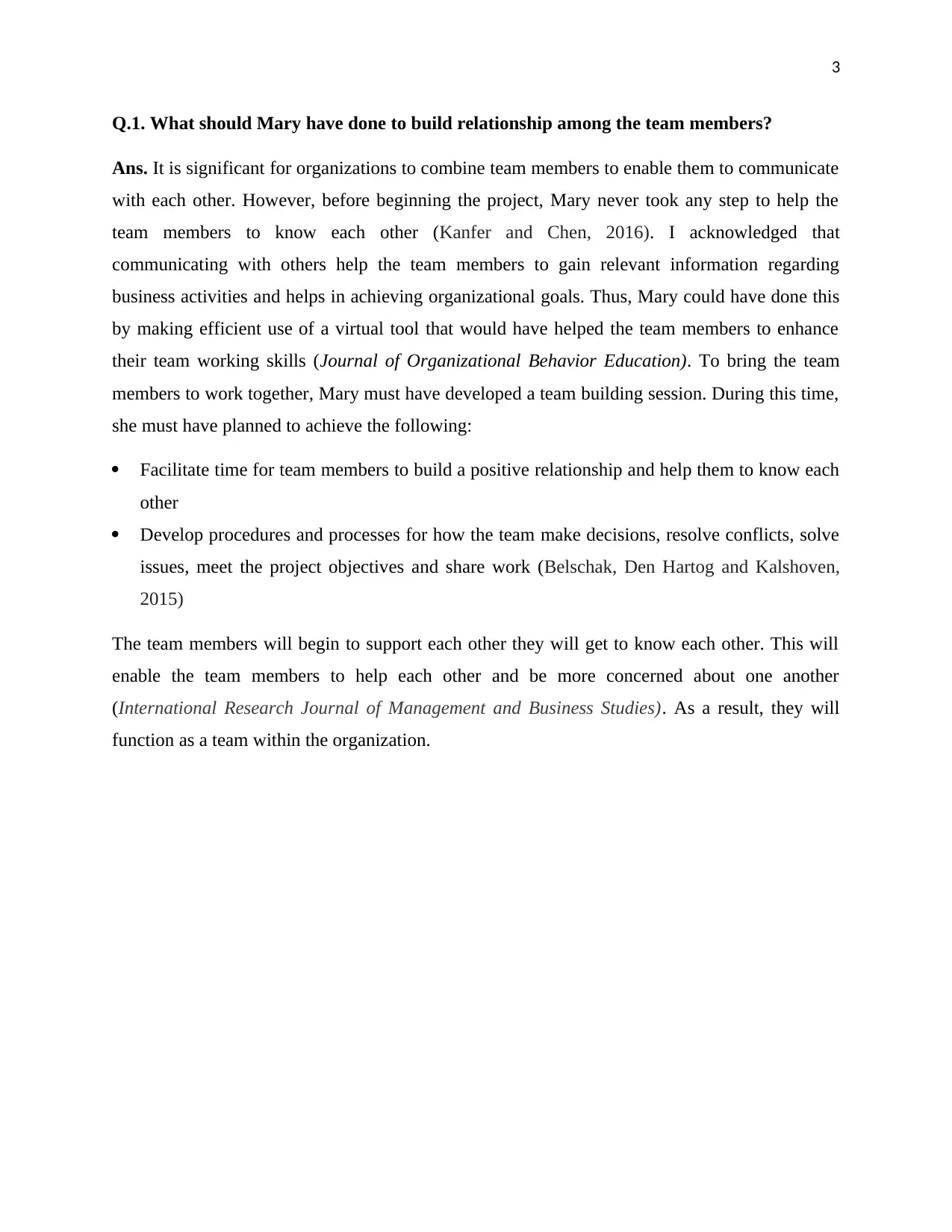
3
Q.1. What should Mary have done to build relationship among the team members?
Ans. It is significant for organizations to combine team members to enable them to communicate
with each other. However, before beginning the project, Mary never took any step to help the
team members to know each other (Kanfer and Chen, 2016). I acknowledged that
communicating with others help the team members to gain relevant information regarding
business activities and helps in achieving organizational goals. Thus, Mary could have done this
by making efficient use of a virtual tool that would have helped the team members to enhance
their team working skills (Journal of Organizational Behavior Education). To bring the team
members to work together, Mary must have developed a team building session. During this time,
she must have planned to achieve the following:
Facilitate time for team members to build a positive relationship and help them to know each
other
Develop procedures and processes for how the team make decisions, resolve conflicts, solve
issues, meet the project objectives and share work (Belschak, Den Hartog and Kalshoven,
2015)
The team members will begin to support each other they will get to know each other. This will
enable the team members to help each other and be more concerned about one another
(International Research Journal of Management and Business Studies). As a result, they will
function as a team within the organization.
Q.1. What should Mary have done to build relationship among the team members?
Ans. It is significant for organizations to combine team members to enable them to communicate
with each other. However, before beginning the project, Mary never took any step to help the
team members to know each other (Kanfer and Chen, 2016). I acknowledged that
communicating with others help the team members to gain relevant information regarding
business activities and helps in achieving organizational goals. Thus, Mary could have done this
by making efficient use of a virtual tool that would have helped the team members to enhance
their team working skills (Journal of Organizational Behavior Education). To bring the team
members to work together, Mary must have developed a team building session. During this time,
she must have planned to achieve the following:
Facilitate time for team members to build a positive relationship and help them to know each
other
Develop procedures and processes for how the team make decisions, resolve conflicts, solve
issues, meet the project objectives and share work (Belschak, Den Hartog and Kalshoven,
2015)
The team members will begin to support each other they will get to know each other. This will
enable the team members to help each other and be more concerned about one another
(International Research Journal of Management and Business Studies). As a result, they will
function as a team within the organization.
Paraphrase This Document
Need a fresh take? Get an instant paraphrase of this document with our AI Paraphraser
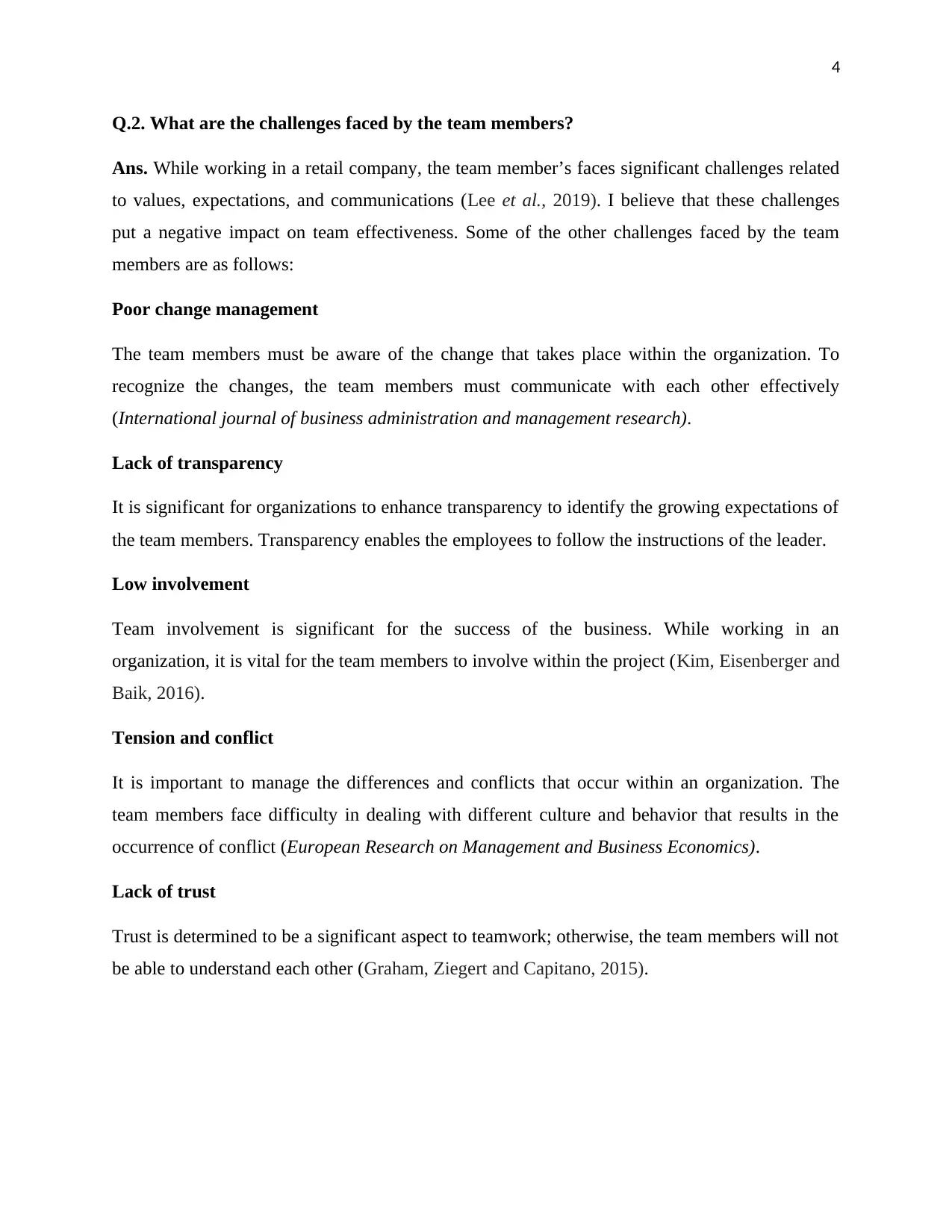
4
Q.2. What are the challenges faced by the team members?
Ans. While working in a retail company, the team member’s faces significant challenges related
to values, expectations, and communications (Lee et al., 2019). I believe that these challenges
put a negative impact on team effectiveness. Some of the other challenges faced by the team
members are as follows:
Poor change management
The team members must be aware of the change that takes place within the organization. To
recognize the changes, the team members must communicate with each other effectively
(International journal of business administration and management research).
Lack of transparency
It is significant for organizations to enhance transparency to identify the growing expectations of
the team members. Transparency enables the employees to follow the instructions of the leader.
Low involvement
Team involvement is significant for the success of the business. While working in an
organization, it is vital for the team members to involve within the project (Kim, Eisenberger and
Baik, 2016).
Tension and conflict
It is important to manage the differences and conflicts that occur within an organization. The
team members face difficulty in dealing with different culture and behavior that results in the
occurrence of conflict (European Research on Management and Business Economics).
Lack of trust
Trust is determined to be a significant aspect to teamwork; otherwise, the team members will not
be able to understand each other (Graham, Ziegert and Capitano, 2015).
Q.2. What are the challenges faced by the team members?
Ans. While working in a retail company, the team member’s faces significant challenges related
to values, expectations, and communications (Lee et al., 2019). I believe that these challenges
put a negative impact on team effectiveness. Some of the other challenges faced by the team
members are as follows:
Poor change management
The team members must be aware of the change that takes place within the organization. To
recognize the changes, the team members must communicate with each other effectively
(International journal of business administration and management research).
Lack of transparency
It is significant for organizations to enhance transparency to identify the growing expectations of
the team members. Transparency enables the employees to follow the instructions of the leader.
Low involvement
Team involvement is significant for the success of the business. While working in an
organization, it is vital for the team members to involve within the project (Kim, Eisenberger and
Baik, 2016).
Tension and conflict
It is important to manage the differences and conflicts that occur within an organization. The
team members face difficulty in dealing with different culture and behavior that results in the
occurrence of conflict (European Research on Management and Business Economics).
Lack of trust
Trust is determined to be a significant aspect to teamwork; otherwise, the team members will not
be able to understand each other (Graham, Ziegert and Capitano, 2015).
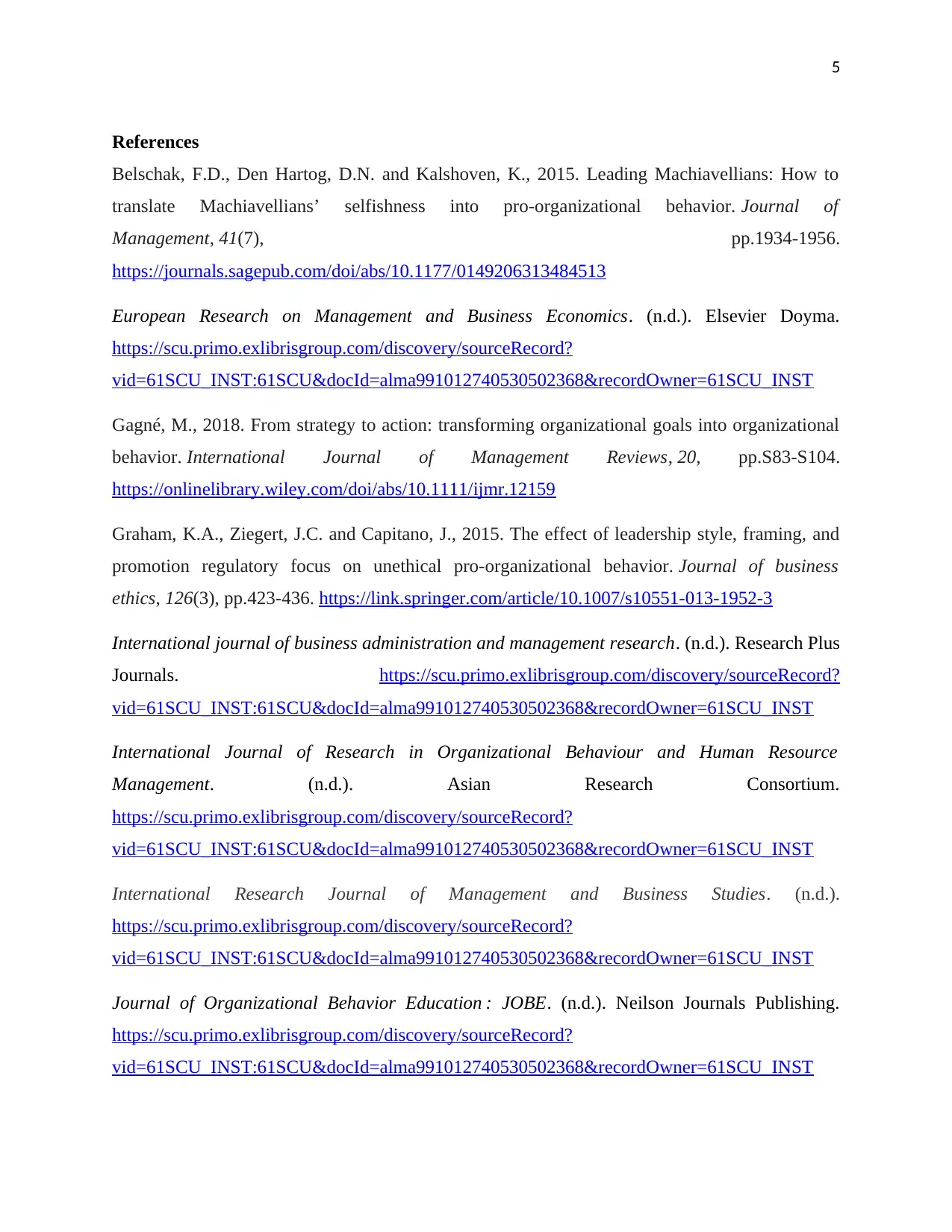
5
References
Belschak, F.D., Den Hartog, D.N. and Kalshoven, K., 2015. Leading Machiavellians: How to
translate Machiavellians’ selfishness into pro-organizational behavior. Journal of
Management, 41(7), pp.1934-1956.
https://journals.sagepub.com/doi/abs/10.1177/0149206313484513
European Research on Management and Business Economics. (n.d.). Elsevier Doyma.
https://scu.primo.exlibrisgroup.com/discovery/sourceRecord?
vid=61SCU_INST:61SCU&docId=alma991012740530502368&recordOwner=61SCU_INST
Gagné, M., 2018. From strategy to action: transforming organizational goals into organizational
behavior. International Journal of Management Reviews, 20, pp.S83-S104.
https://onlinelibrary.wiley.com/doi/abs/10.1111/ijmr.12159
Graham, K.A., Ziegert, J.C. and Capitano, J., 2015. The effect of leadership style, framing, and
promotion regulatory focus on unethical pro-organizational behavior. Journal of business
ethics, 126(3), pp.423-436. https://link.springer.com/article/10.1007/s10551-013-1952-3
International journal of business administration and management research. (n.d.). Research Plus
Journals. https://scu.primo.exlibrisgroup.com/discovery/sourceRecord?
vid=61SCU_INST:61SCU&docId=alma991012740530502368&recordOwner=61SCU_INST
International Journal of Research in Organizational Behaviour and Human Resource
Management. (n.d.). Asian Research Consortium.
https://scu.primo.exlibrisgroup.com/discovery/sourceRecord?
vid=61SCU_INST:61SCU&docId=alma991012740530502368&recordOwner=61SCU_INST
International Research Journal of Management and Business Studies. (n.d.).
https://scu.primo.exlibrisgroup.com/discovery/sourceRecord?
vid=61SCU_INST:61SCU&docId=alma991012740530502368&recordOwner=61SCU_INST
Journal of Organizational Behavior Education : JOBE. (n.d.). Neilson Journals Publishing.
https://scu.primo.exlibrisgroup.com/discovery/sourceRecord?
vid=61SCU_INST:61SCU&docId=alma991012740530502368&recordOwner=61SCU_INST
References
Belschak, F.D., Den Hartog, D.N. and Kalshoven, K., 2015. Leading Machiavellians: How to
translate Machiavellians’ selfishness into pro-organizational behavior. Journal of
Management, 41(7), pp.1934-1956.
https://journals.sagepub.com/doi/abs/10.1177/0149206313484513
European Research on Management and Business Economics. (n.d.). Elsevier Doyma.
https://scu.primo.exlibrisgroup.com/discovery/sourceRecord?
vid=61SCU_INST:61SCU&docId=alma991012740530502368&recordOwner=61SCU_INST
Gagné, M., 2018. From strategy to action: transforming organizational goals into organizational
behavior. International Journal of Management Reviews, 20, pp.S83-S104.
https://onlinelibrary.wiley.com/doi/abs/10.1111/ijmr.12159
Graham, K.A., Ziegert, J.C. and Capitano, J., 2015. The effect of leadership style, framing, and
promotion regulatory focus on unethical pro-organizational behavior. Journal of business
ethics, 126(3), pp.423-436. https://link.springer.com/article/10.1007/s10551-013-1952-3
International journal of business administration and management research. (n.d.). Research Plus
Journals. https://scu.primo.exlibrisgroup.com/discovery/sourceRecord?
vid=61SCU_INST:61SCU&docId=alma991012740530502368&recordOwner=61SCU_INST
International Journal of Research in Organizational Behaviour and Human Resource
Management. (n.d.). Asian Research Consortium.
https://scu.primo.exlibrisgroup.com/discovery/sourceRecord?
vid=61SCU_INST:61SCU&docId=alma991012740530502368&recordOwner=61SCU_INST
International Research Journal of Management and Business Studies. (n.d.).
https://scu.primo.exlibrisgroup.com/discovery/sourceRecord?
vid=61SCU_INST:61SCU&docId=alma991012740530502368&recordOwner=61SCU_INST
Journal of Organizational Behavior Education : JOBE. (n.d.). Neilson Journals Publishing.
https://scu.primo.exlibrisgroup.com/discovery/sourceRecord?
vid=61SCU_INST:61SCU&docId=alma991012740530502368&recordOwner=61SCU_INST
⊘ This is a preview!⊘
Do you want full access?
Subscribe today to unlock all pages.

Trusted by 1+ million students worldwide
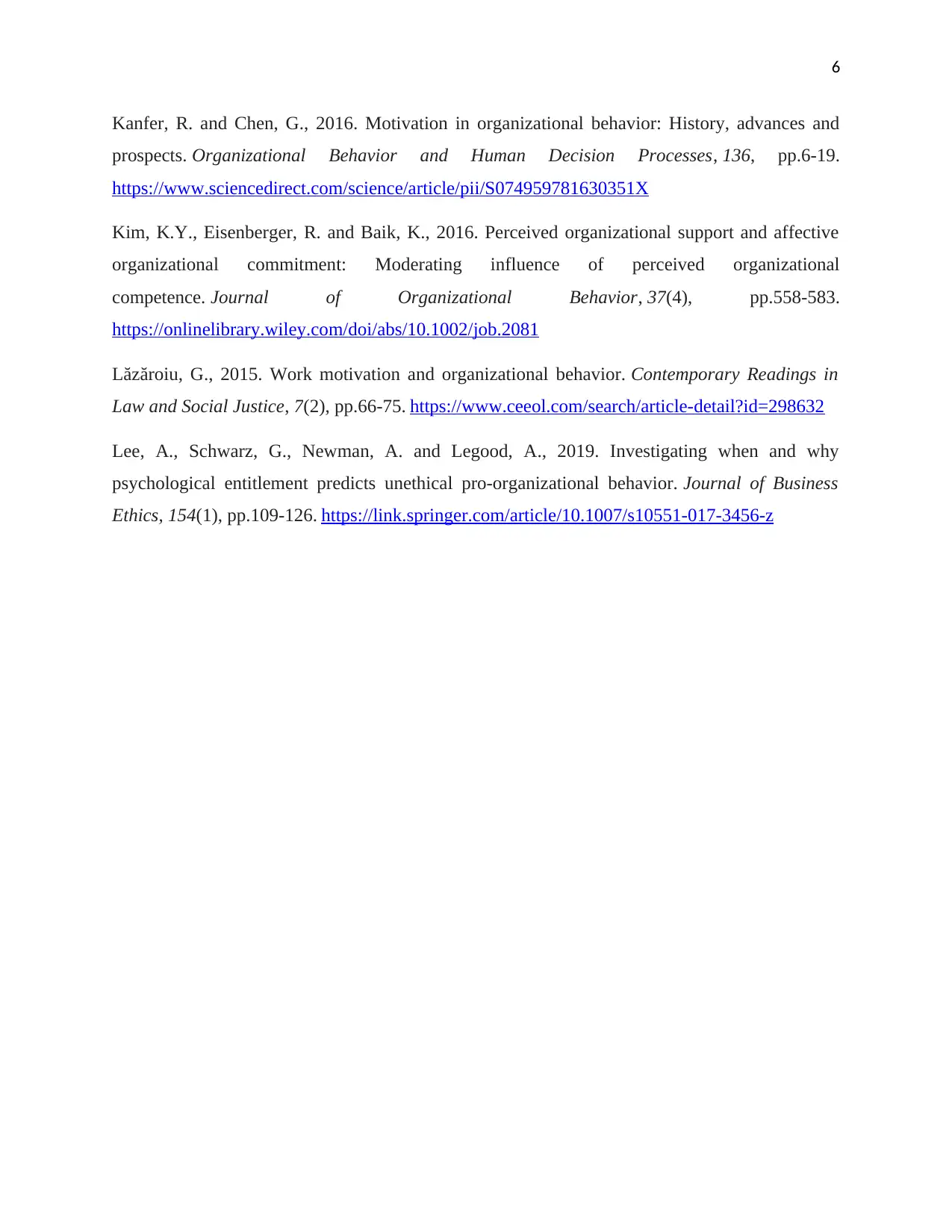
6
Kanfer, R. and Chen, G., 2016. Motivation in organizational behavior: History, advances and
prospects. Organizational Behavior and Human Decision Processes, 136, pp.6-19.
https://www.sciencedirect.com/science/article/pii/S074959781630351X
Kim, K.Y., Eisenberger, R. and Baik, K., 2016. Perceived organizational support and affective
organizational commitment: Moderating influence of perceived organizational
competence. Journal of Organizational Behavior, 37(4), pp.558-583.
https://onlinelibrary.wiley.com/doi/abs/10.1002/job.2081
Lăzăroiu, G., 2015. Work motivation and organizational behavior. Contemporary Readings in
Law and Social Justice, 7(2), pp.66-75. https://www.ceeol.com/search/article-detail?id=298632
Lee, A., Schwarz, G., Newman, A. and Legood, A., 2019. Investigating when and why
psychological entitlement predicts unethical pro-organizational behavior. Journal of Business
Ethics, 154(1), pp.109-126. https://link.springer.com/article/10.1007/s10551-017-3456-z
Kanfer, R. and Chen, G., 2016. Motivation in organizational behavior: History, advances and
prospects. Organizational Behavior and Human Decision Processes, 136, pp.6-19.
https://www.sciencedirect.com/science/article/pii/S074959781630351X
Kim, K.Y., Eisenberger, R. and Baik, K., 2016. Perceived organizational support and affective
organizational commitment: Moderating influence of perceived organizational
competence. Journal of Organizational Behavior, 37(4), pp.558-583.
https://onlinelibrary.wiley.com/doi/abs/10.1002/job.2081
Lăzăroiu, G., 2015. Work motivation and organizational behavior. Contemporary Readings in
Law and Social Justice, 7(2), pp.66-75. https://www.ceeol.com/search/article-detail?id=298632
Lee, A., Schwarz, G., Newman, A. and Legood, A., 2019. Investigating when and why
psychological entitlement predicts unethical pro-organizational behavior. Journal of Business
Ethics, 154(1), pp.109-126. https://link.springer.com/article/10.1007/s10551-017-3456-z
1 out of 7
Related Documents
Your All-in-One AI-Powered Toolkit for Academic Success.
+13062052269
info@desklib.com
Available 24*7 on WhatsApp / Email
![[object Object]](/_next/static/media/star-bottom.7253800d.svg)
Unlock your academic potential
Copyright © 2020–2025 A2Z Services. All Rights Reserved. Developed and managed by ZUCOL.



